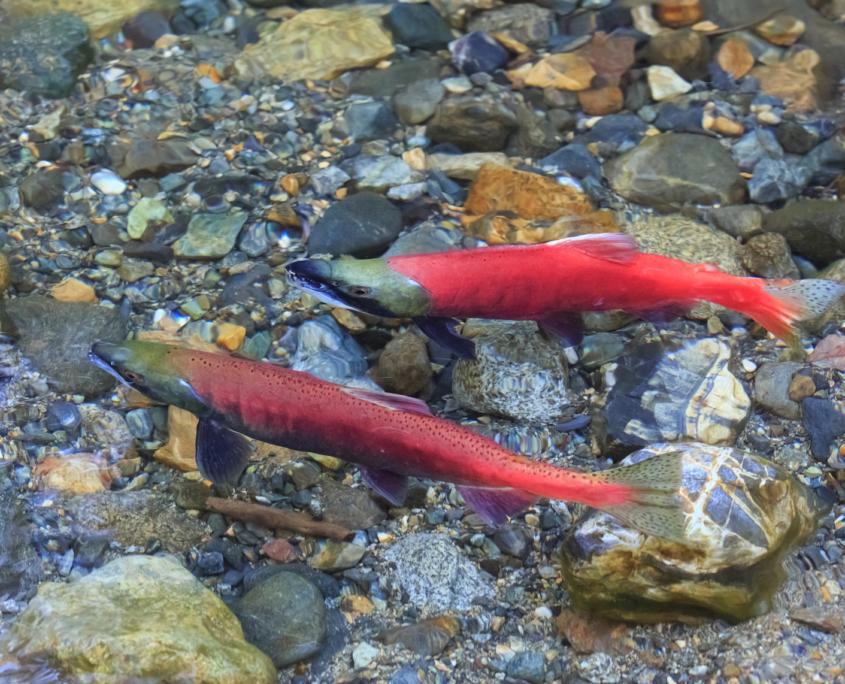Get Outdoors!: Behold! Migration season is upon us in North Okanagan
 Some people think that hummingbirds catch rides on the backs of geese for their migratory trip down south.
Some people think that hummingbirds catch rides on the backs of geese for their migratory trip down south.
Truth is; hummingbirds are well on their way to Mexico when the geese are just taking their “practice flights” for migration to the coast or just into the warmer United States.
Physics gives hummingbirds an advantage with a smaller, light body weight.
They just need to refuel all along the way to maintain their energy. That’s why all hummingbird feeders should be taken down by mid August. If the “hummers” stay too late, they could succumb to freezing.
Big Canada Geese, on the other hand, store fat for their trip. That’s why they’ve adopted the energy efficient “V” flight formation.
Our Great Blue Herons (that nest on 24th St.) have already been dispersing to various open-water lakes for the winter.
Some may migrate to the coast to winter on good fishing grounds.
Most birds migrate at night following the stars (like sailors) along migratory pathways (usually air currents of least resistance).
Some of our birds migrate all the way down to South America.
I love sitting back on mosquito-less, moonlit September and October nights with binoculars in hand to spot flocks passing in the night sky.
If you’re in a quiet spot; listen. Could it be the calls of migrating flocks or the rustle of dry leaves in the breeze?
You might even see bats migrating to their winter colonies further south. Their “flutter” of wings distinguishes them from birds.
Don’t come to the Allan Brooks Nature Centre looking for the yellow-bellied marmots now.
These large rodents, like the Columbian Ground Squirrels, have gone underground for an early rest to “estivate” while they’re still fat from summer’s seed bounty.
They re-emerge with young in April.
Snakes, frogs and other reptiles and amphibians are moving towards their wintering grounds now, too.
Watch for late emerging Mourning Cloak and Tortoiseshell butterflies in the fall. They’ll overwinter here tucked behind bark or in tree grooves. The large yellow and black butterflies are non-migrating Swallowtails, often mistaken for the orange and black migrating Monarchs.
Don’t miss watching the Kokanee spawn on Coldstream Creek in late September to early October.
The best spawning beds for viewing are in Creekside and Coldstream Parks (behind Coldstream School).
These Sockeye Salmon descendants became “land-locked” as the glacial-produced massive waterways, which once connected to the Pacific, drained and evaporated into separate lakes.
For thousands of years Kokanee annually spawned to lay eggs in gravel creekbeds and shorelines.
Until the early 1900s, almost every major creek flowing into Okanagan Lake supported thousands of spawning Kokanee each fall.
I’ve seen a sharp decline in spawning numbers in the past 25 years.
Get out there with your children and friends to enjoy this miraculous phenomena before it dies out (or can we save the Kokanee?).
Leave your pets at home!
Fall’s a great time to observe nature.
Thankfully, Vernon has many opportunities to enjoy it:
- Visit the Allan Brooks Nature Centre. www.abnc.ca.
- The North Okanagan Naturalist Club welcomes anyone interested to join their free Saturday morning nature hikes. www.nonc.ca
- Join the Vernon Outdoors Club for a variety of great fall hikes and cycles.
- There’s many hiking groups on Facebook.
Fortunately we’re surrounded by spectacular provincial parks: Camp and/or hike Kalamalka Lake, Ellison, Kekuli Bay, Sovereign Lake, Mabel Lake, Fintry and Bear Creek.
This article is written for the Vernon Morning Star by Roseanne Van Ee. Roseanne enthusiastically shares her knowledge of the outdoors to help readers experience and enjoy nature. Discover exciting and adventurous natural events, best trails, and wild places. Follow her on Facebook for more.

Leave a Reply
Want to join the discussion?Feel free to contribute!